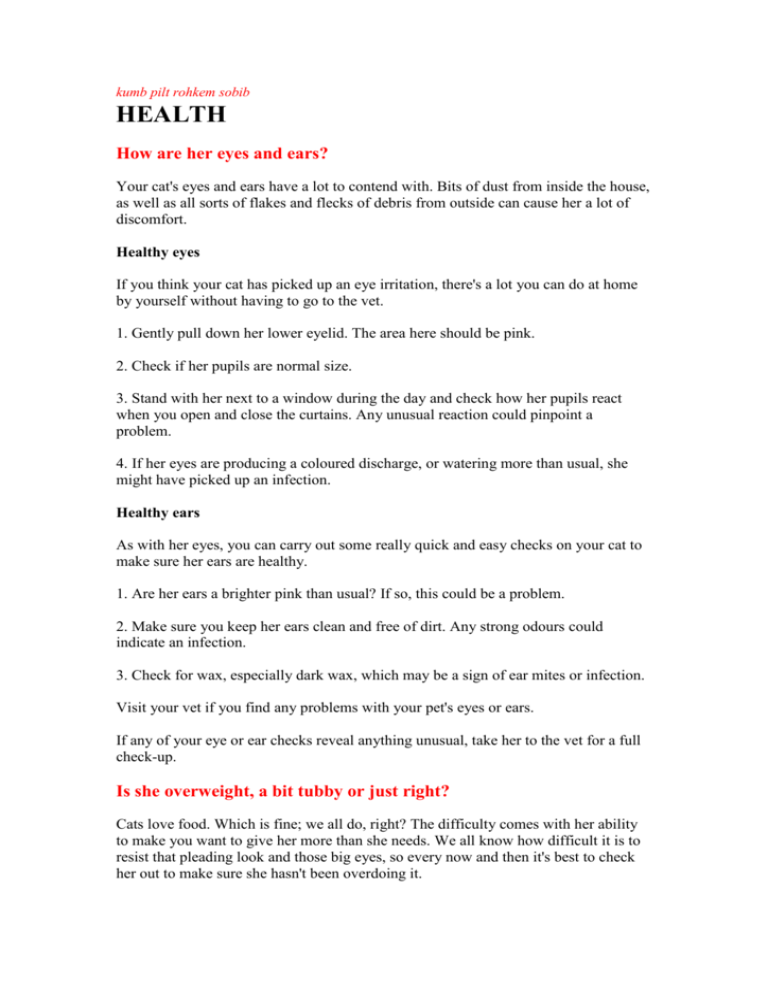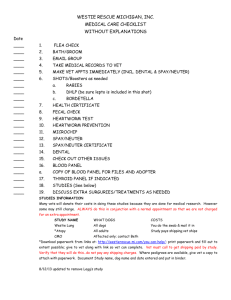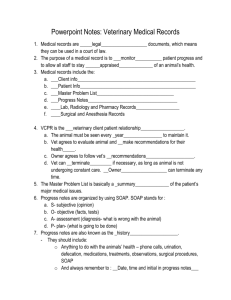health
advertisement

kumb pilt rohkem sobib HEALTH How are her eyes and ears? Your cat's eyes and ears have a lot to contend with. Bits of dust from inside the house, as well as all sorts of flakes and flecks of debris from outside can cause her a lot of discomfort. Healthy eyes If you think your cat has picked up an eye irritation, there's a lot you can do at home by yourself without having to go to the vet. 1. Gently pull down her lower eyelid. The area here should be pink. 2. Check if her pupils are normal size. 3. Stand with her next to a window during the day and check how her pupils react when you open and close the curtains. Any unusual reaction could pinpoint a problem. 4. If her eyes are producing a coloured discharge, or watering more than usual, she might have picked up an infection. Healthy ears As with her eyes, you can carry out some really quick and easy checks on your cat to make sure her ears are healthy. 1. Are her ears a brighter pink than usual? If so, this could be a problem. 2. Make sure you keep her ears clean and free of dirt. Any strong odours could indicate an infection. 3. Check for wax, especially dark wax, which may be a sign of ear mites or infection. Visit your vet if you find any problems with your pet's eyes or ears. If any of your eye or ear checks reveal anything unusual, take her to the vet for a full check-up. Is she overweight, a bit tubby or just right? Cats love food. Which is fine; we all do, right? The difficulty comes with her ability to make you want to give her more than she needs. We all know how difficult it is to resist that pleading look and those big eyes, so every now and then it's best to check her out to make sure she hasn't been overdoing it. Give her a home check-up Most obviously, you can weigh her. Just step up on your scales with her in your arms and subtract your weight from that of the two of you combined. You can also keep an eye out for changes in her body weight by standing above her and checking for a slight "waist" behind her ribs. If you're still not sure, place both your hands on her sides. Can you feel her ribs? Then she's at her ideal weight (but if they're sticking out she's too thin!). Look out for pouches of fat between her hind legs and under her belly too. Dealing with an overweight cat If she's starting to look a little on the podgy side, your vet can probably suggest a diet plan. It's time to put a stop to all those treats and snacks, and, since it's better for her to eat little and often (rather than gorging on a feast), see how she feels about having four small meals a day instead of two bigger ones. Make sure she gets some exercise too. It's best to ease her in with short bursts of activity, gradually adding five minutes here and there until eventually she's able to do a full workout. And if she's underweight? Make sure you follow your vet's advice when it comes to how much, and how often, to feed your cat. If she's still underweight and you're not sure why, she could be poorly. Take her back to the vet for a check-up and you'll get all the advice you need. Skin and ear care If your cat's spending a lot of time shaking her head or scratching at her ear, or if there's some goo coming out, she might have an infection. Tiny mites which live in the ear canal can sometimes be the cause, so ask your vet for eardrops or a special 'spot on' that's applied to her shoulder blades. If there are any other cats in the house, it's safest to treat them too. Before attempting anything too serious, please ask your vet for advice. Sometimes cats can develop a cauliflower-like thickening of the outer ear. It'll need to be cleaned regularly (ask your vet for a treatment) to stop the wax building up, and could be with her for life. Your vet may also check for 'polyps', fleshy lumps which can prevent air flowing into her ear and cause some pretty serious illnesses. Ask your vet about having them removed by surgery. Another problem is a sudden swelling of the ear flap, which can be a blood blister. This happens when a vein bursts and blood drips into the ear, usually caused by scratching. The ear flap may scar and crumple, which could damage your cat's hearing and end up looking quite unsightly. Again, your vet can advise you about an operation to reduce the problem. Eczema can also cause problems for cats. It's often caused by an allergic reaction to flea bites. Scabs will develop giving her coat a gritty feel. If she's in discomfort, she may start to lick herself more than usual. Unfortunately this only causes more damage and irritation. Speak to your vet about suitable treatment. Sometimes itchy skin can be caused by a food allergy, so seek advice from your vet about putting your cat on a different diet. The Vet As soon as your new kitten sets paw in her new home for the first time she's relying on you to take good care of her. So register her with the vet as soon as you can! It’s also a good idea to keep a file with all her health documents in one place. You can keep the vet's phone number here too, so it’s easy to find if you need it. If you can afford it, think about taking out pet insurance as treatment after accidents can often turn out pricey. You're very unlikely to need it, but where your little one's concerned safe is always better than sorry. Her first appointment Your kitten can't tell you what's wrong, so if she's acting up or seems to be a bit down in the dumps, it's important that you take her to the vet, just to be on the safe side. The journey Kittens are often afraid when taken to the vet for the first time. If they haven’t been in the car before, all the new sounds and smells can be a little much. To make the journey much more pleasant for your little one, we’d recommend a cat carrier with a secure lock. It’s all too easy to escape from an ordinary cardboard box, or from your arms. She'll feel much more comfortable if you turn the carrier into a home away from home by putting something with her smell on it inside. The blanket from her basket is perfect. You could even do a trial run by letting her use her carrier as a bed or hiding place for a few days before the journey. At the vet’s Once you've arrived at the vet’s, keep your kitten inside her carrier. She'll feel safer inside, particularly if there are lots of loud, barking dogs and other cats around. You can help create a friendly, fun environment for her inside the carrier by giving her a toy to play with, as well as a few treats. When it’s her turn to be seen by the vet, stay with her. She'll associate your voice with nice things like feeding time and play, so stroking and talking to her will help her feel more secure, and the vet will be thankful for your help. Remember, if her first visit is a success, it's even more likely that future visits will be too! Be prepared At the first appointment, your vet will tell you everything you need to know to be sure your kitten stays in great physical and mental shape. The vet will also mention any health risks that you should be aware of. Over to you While the vet's role is important, the real centre of your kitten’s universe is you, and her wellbeing depends on your knowledge and attention. That's why you should start checking her mouth and teeth as early as possible. It'll be much easier to clean her teeth properly if you're really familiar with her little fangs. It’s especially important to check her front teeth and incisors for tartar. If you notice red, swollen gums, take her to the vet and she'll soon be right as rain. Aim to have her teeth checked at least once a year, maybe along with her annual vaccinations. However much she miaows in complaint, it's important that the two of you get into a good grooming, worming and de-fleaing routine, along with regular check-ups and all necessary booster vaccinations. Shower her with love and she'll soon forget to complain. When to vaccinate and why Being a loving, responsible owner, it's important for you to read up on the health risks your kitten could face. It's not nice to think about, but if you pick up all the know-how you need early then, fingers crossed, you'll never have to use it. Feline infectious enteritis (FIE), feline viral rhinotracheitis (FVR), feline calicivirus (FCV) and cat influenza are all very infectious and can prove dangerous for kittens. Fortunately, however, there are vaccines against all of them. Your kitten's first injections will usually be given at nine weeks, followed by a second lot at 12 weeks – however, some vaccines can differ so it is best to check with your vet when your kitten needs their vaccines. The influenza vaccine is often given as nose drops rather than by injection. It takes up to a fortnight after vaccination for her immunity to fully develop, so during that time and probably much to her disgust, you’ll have to keep her indoors. And remember, she'll need to have booster injections every year. Be sure you keep her vaccination certificates in a safe place (preferably together with all kitten-based paperwork in a folder). If you ever want to leave her in a cattery when she’s older, they'll need this information. If you're planning on taking your little one on holiday overseas, vaccination against rabies is a must. Just to be on the safe side you might consider other vaccinations, perhaps against feline leukaemia virus or feline chlamydia. Ask your vet for help.







